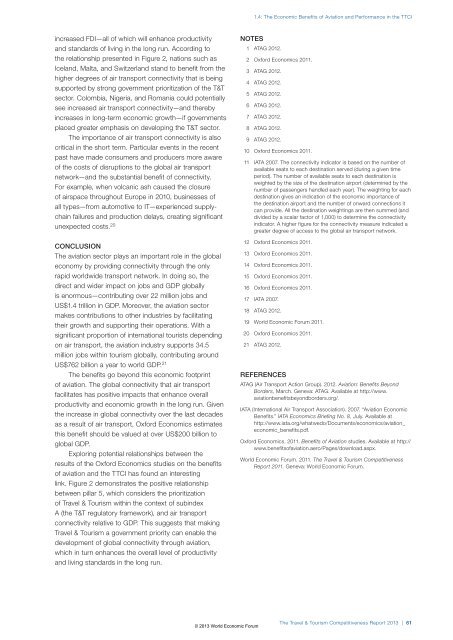The Travel & Tourism Competitiveness Report 2013
The Travel & Tourism Competitiveness Report 2013
The Travel & Tourism Competitiveness Report 2013
You also want an ePaper? Increase the reach of your titles
YUMPU automatically turns print PDFs into web optimized ePapers that Google loves.
increased FDI—all of which will enhance productivity<br />
and standards of living in the long run. According to<br />
the relationship presented in Figure 2, nations such as<br />
Iceland, Malta, and Switzerland stand to benefit from the<br />
higher degrees of air transport connectivity that is being<br />
supported by strong government prioritization of the T&T<br />
sector. Colombia, Nigeria, and Romania could potentially<br />
see increased air transport connectivity—and thereby<br />
increases in long-term economic growth—if governments<br />
placed greater emphasis on developing the T&T sector.<br />
<strong>The</strong> importance of air transport connectivity is also<br />
critical in the short term. Particular events in the recent<br />
past have made consumers and producers more aware<br />
of the costs of disruptions to the global air transport<br />
network—and the substantial benefit of connectivity.<br />
For example, when volcanic ash caused the closure<br />
of airspace throughout Europe in 2010, businesses of<br />
all types—from automotive to IT—experienced supplychain<br />
failures and production delays, creating significant<br />
unexpected costs. 20<br />
CONCLUSION<br />
<strong>The</strong> aviation sector plays an important role in the global<br />
economy by providing connectivity through the only<br />
rapid worldwide transport network. In doing so, the<br />
direct and wider impact on jobs and GDP globally<br />
is enormous—contributing over 22 million jobs and<br />
US$1.4 trillion in GDP. Moreover, the aviation sector<br />
makes contributions to other industries by facilitating<br />
their growth and supporting their operations. With a<br />
significant proportion of international tourists depending<br />
on air transport, the aviation industry supports 34.5<br />
million jobs within tourism globally, contributing around<br />
US$762 billion a year to world GDP. 21<br />
<strong>The</strong> benefits go beyond this economic footprint<br />
of aviation. <strong>The</strong> global connectivity that air transport<br />
facilitates has positive impacts that enhance overall<br />
productivity and economic growth in the long run. Given<br />
the increase in global connectivity over the last decades<br />
as a result of air transport, Oxford Economics estimates<br />
this benefit should be valued at over US$200 billion to<br />
global GDP.<br />
Exploring potential relationships between the<br />
results of the Oxford Economics studies on the benefits<br />
of aviation and the TTCI has found an interesting<br />
link. Figure 2 demonstrates the positive relationship<br />
between pillar 5, which considers the prioritization<br />
of <strong>Travel</strong> & <strong>Tourism</strong> within the context of subindex<br />
A (the T&T regulatory framework), and air transport<br />
connectivity relative to GDP. This suggests that making<br />
<strong>Travel</strong> & <strong>Tourism</strong> a government priority can enable the<br />
development of global connectivity through aviation,<br />
which in turn enhances the overall level of productivity<br />
and living standards in the long run.<br />
© <strong>2013</strong> World Economic Forum<br />
1.4: <strong>The</strong> Economic Benefits of Aviation and Performance in the TTCI<br />
NOTES<br />
1 ATAG 2012.<br />
2 Oxford Economics 2011.<br />
3 ATAG 2012.<br />
4 ATAG 2012.<br />
5 ATAG 2012.<br />
6 ATAG 2012.<br />
7 ATAG 2012.<br />
8 ATAG 2012.<br />
9 ATAG 2012.<br />
10 Oxford Economics 2011.<br />
11 IATA 2007. <strong>The</strong> connectivity indicator is based on the number of<br />
available seats to each destination served (during a given time<br />
period). <strong>The</strong> number of available seats to each destination is<br />
weighted by the size of the destination airport (determined by the<br />
number of passengers handled each year). <strong>The</strong> weighting for each<br />
destination gives an indication of the economic importance of<br />
the destination airport and the number of onward connections it<br />
can provide. All the destination weightings are then summed (and<br />
divided by a scalar factor of 1,000) to determine the connectivity<br />
indicator. A higher figure for the connectivity measure indicated a<br />
greater degree of access to the global air transport network.<br />
12 Oxford Economics 2011.<br />
13 Oxford Economics 2011.<br />
14 Oxford Economics 2011.<br />
15 Oxford Economics 2011.<br />
16 Oxford Economics 2011.<br />
17 IATA 2007.<br />
18 ATAG 2012.<br />
19 World Economic Forum 2011.<br />
20 Oxford Economics 2011.<br />
21 ATAG 2012.<br />
REFERENCES<br />
ATAG (Air Transport Action Group). 2012. Aviation: Benefits Beyond<br />
Borders, March. Geneva: ATAG. Available at http://www.<br />
aviationbenefitsbeyondborders.org/.<br />
IATA (International Air Transport Association). 2007. “Aviation Economic<br />
Benefits.” IATA Economics Briefing No. 8, July. Available at<br />
http://www.iata.org/whatwedo/Documents/economics/aviation_<br />
economic_benefits.pdf.<br />
Oxford Economics. 2011. Benefits of Aviation studies. Available at http://<br />
www.benefitsofaviation.aero/Pages/download.aspx.<br />
World Economic Forum. 2011. <strong>The</strong> <strong>Travel</strong> & <strong>Tourism</strong> <strong>Competitiveness</strong><br />
<strong>Report</strong> 2011. Geneva: World Economic Forum.<br />
<strong>The</strong> <strong>Travel</strong> & <strong>Tourism</strong> <strong>Competitiveness</strong> <strong>Report</strong> <strong>2013</strong> | 61

















